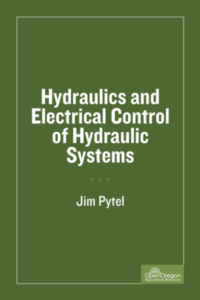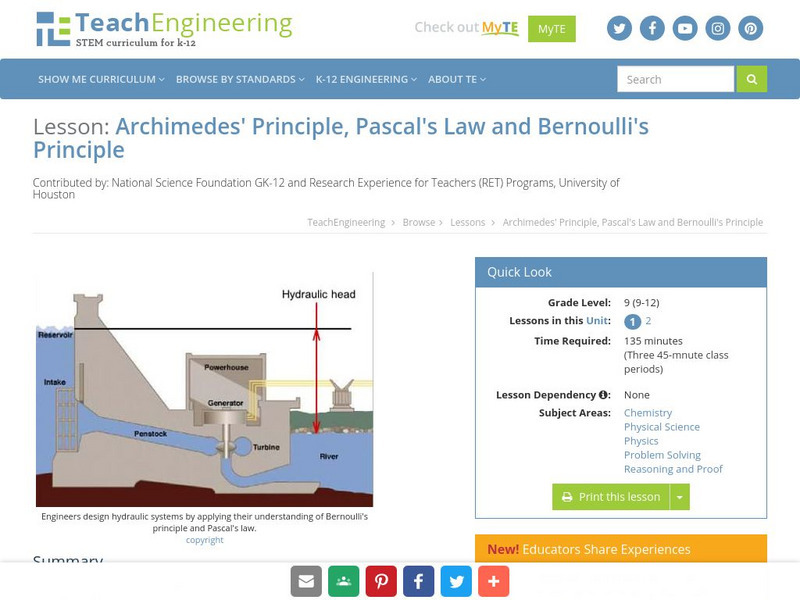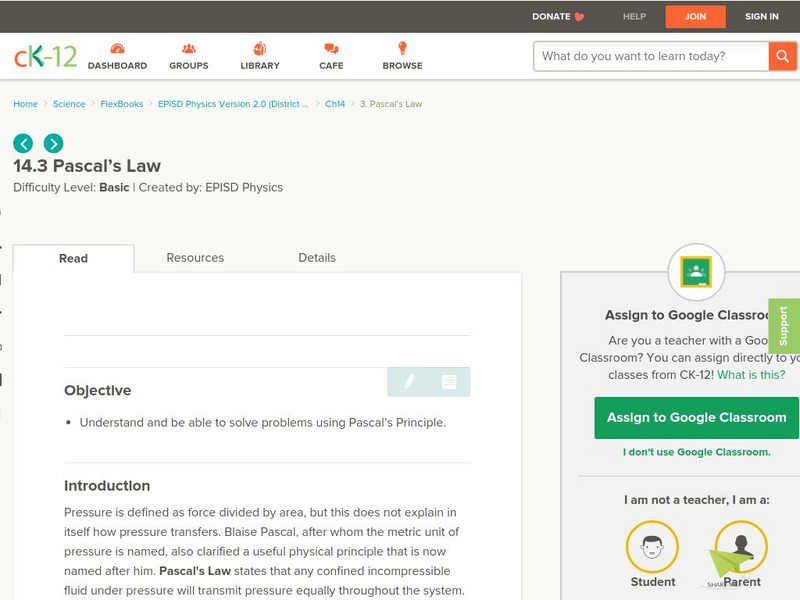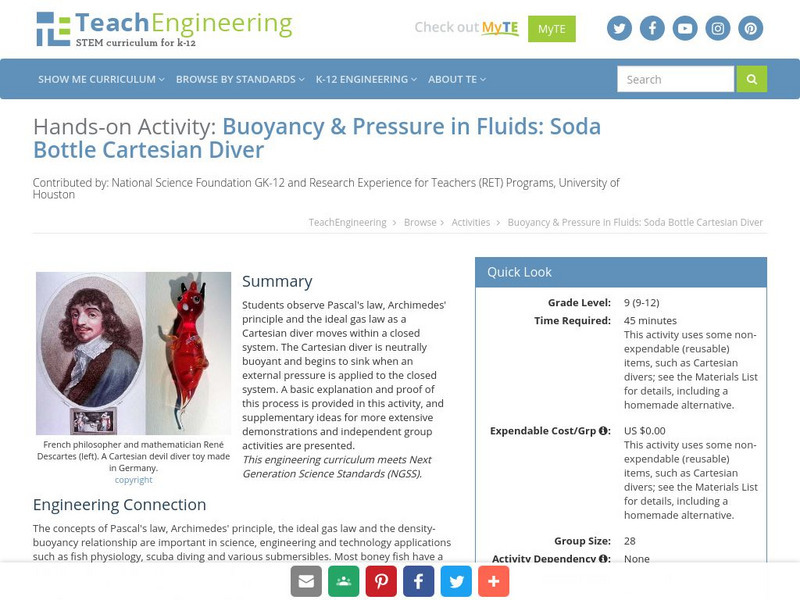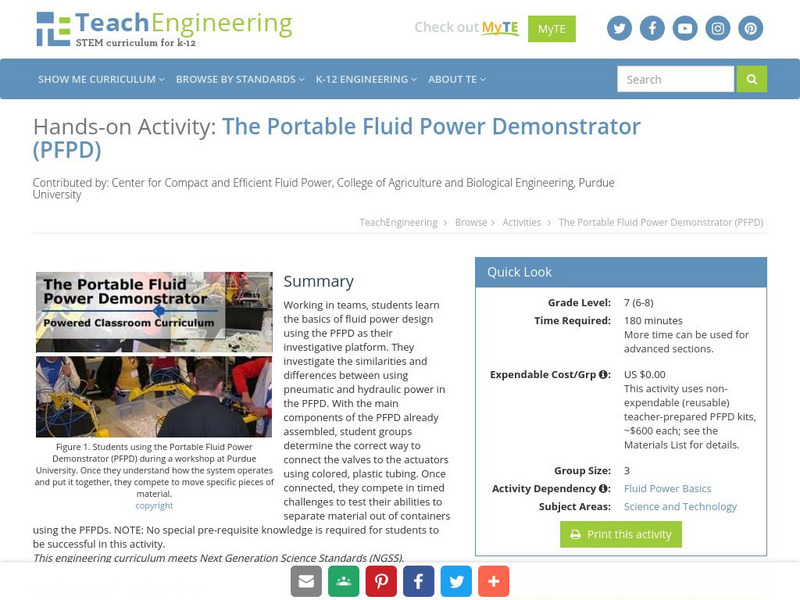Teach Engineering
Archimedes' Principle, Pascal's Law and Bernoulli's Principle
What do Pascal's law, Archimedes' Principle, and Bernoulli's Principle have to do with fluid mechanics? The included PowerPoint presentation provides the basic definitions and equations associated with the three. A set of homework...
Royal Society of Chemistry
Gas Laws: Converting Units
Given a choice between playing a game or completing a worksheet, which do you think your class would choose? Tap into their reasoning skills with a series of puzzles focused on gas laws unit conversion. You can use the resource online or...
Teach Engineering
Cartesian Diver
Amaze your scholars with an activity that uses a Cartesian diver to demonstrate Pascal's Law, Archimedes' Principle, and the Ideal Gas Law. Groups then repeat the process and make their own diver move up and down in a bottle.
Teach Engineering
Above-Ground Storage Tanks in the Houston Ship Channel
Introduce your class to storage tank failures caused by major storms with an activity that looks at how the concepts of Archimedes' Principle and Pascal's Law affect the storage tanks along the Houston Ship Channel. The background...
Open Oregon Educational Resources
Hydraulics and Electrical Control of Hydraulic Systems
It's all systems go for learning about hydraulic systems. An eBook provides a set of videos and exercise questions for a semester-long course on hydraulics. Six units introduce hydraulics, Pascal's law, hydraulic applications, flow...
Science Geek
Measurement of Pressure and Temperature
We all have standards and scientists are no exception. Presentation covers standard temperature, standard pressure, temperature conversions, and absolute zero. It explains pressure using pascals, mm of mercury, atmosphere, and torr, then...
Curated OER
Liquid Pressure
Fifth graders create a Cartesian Diver model made from plastic soap bottle and medicine dropper. In this incompressible liquid lesson, 5th graders experiment with jugs of water to demonstrate Pascal's Law, Boyle's Law and...
Curated OER
Honors Chemistry Gas Laws Worksheet
In this gas worksheet, students solve eighteen problems using a variety of gas laws. They find temperatures, pressures, partial pressures, moles, molecular formulas and volumes of gases.
Teach Engineering
Above-Ground Storage Tank Design Project
The challenge: determine whether a tank will float. A design activity has groups work as engineering teams in order to determine the stability of given tanks and liquid contents. The teams need to determine the equations to...
Curated OER
Scientist/ Webelos Activity Book
In this physical science instructional activity, students write short responses for each scientific law in 14 different questions to obtain a merit badge.
Rice University
College Physics for AP® Courses
Take a look at an organized physics course. The 34-section electronic textbook covers material in AP® Physics 1 and 2. Teachers use the text to supplement lectures and have the class work through the labs. Each section contains...
Curated OER
Locks and Dams
Students learn about locks and dams when it comes to blocking water. In this dam instructional activity, students learn about the structure, function, and purpose of locks and dams. They also learn about water pressure and gravity.
Curated OER
Behavior of Liquids and Gases
In this liquids and gases learning exercise, high schoolers review 9 vocabulary terms associated with liquids and gases by completing a crossword puzzle.
Curated OER
Bernoulli's Principle
Learners explore Bernoulli's principle, how it is related to flight, and the effect of lift, thrust, and drag on flight. They design and develop an experiment that tests for distance traveled by their paper airplane, and record and...
Curated OER
FORCES, MOTION, AND ENERGY
Eighth graders engage in a variety of activities in order to investigate the basic concepts of physics. They read and answer questions in a written text. This is only one type of activity that is part of many others.
Curated OER
Atoms, Kinetic Theory, Solids and Fluids
Students identify and describe the building blocks that make up an atom. They also compare the ages of atoms to the ages of the materials they compose,as well as, give examples that illustrate the small size of atoms.
TeachEngineering
Teach Engineering: Archimedes' Principle, Pascal's Law and Bernoulli's Principle
Students are introduced to Pascal's law, Archimedes' principle, and Bernoulli's principle through problems and engineering applications.
CK-12 Foundation
Ck 12: Pascal's Law
[Free Registration/Login may be required to access all resource tools.] The use of Pascal's Principle to solve pressure problems is explained.
TeachEngineering
Teach Engineering: Cartesian Diver
Students observe Pascal's law, Archimedes' principle, and the ideal gas law as a Cartesian diver moves within a closed system.
TeachEngineering
Teach Engineering: Under Pressure
Students learn about Pascal's law, an important concept behind the engineering of dam and lock systems, such as the one that Thirsty County wants Splash Engineering to design for the Birdseye River (an ongoing hypothetical engineering...
TeachEngineering
Teach Engineering: Locks and Dams
Students are introduced to the structure, function and purpose of locks and dams, which involves an introduction to Pascal's law, water pressure and gravity.
New Advent
Catholic Encyclopedia: Blaise Pascal
Excellent discussion of the life and work of this great scientist and mathematician. Describes his range of interests and notes his many contributions. Please note that ?The Catholic Encyclopedia? is a historic reference source and...
TeachEngineering
Teach Engineering: The Portable Fluid Power Demonstrator (Pfpd)
Working as teams, students learn the basics of fluid power design using the PFPD as their investigative platform. Students will investigate the similarities and differences between using pneumatic and hydraulic power in the PFPD. While...
TeachEngineering
Teach Engineering: Fluid Power Basics
Students learn about the basic fundamental concepts regarding fluid power, which includes both pneumatic, which utilize gas, and hydraulic, which utilize liquid, systems. Both systems contain four basic components: a reservoir, a pump or...






